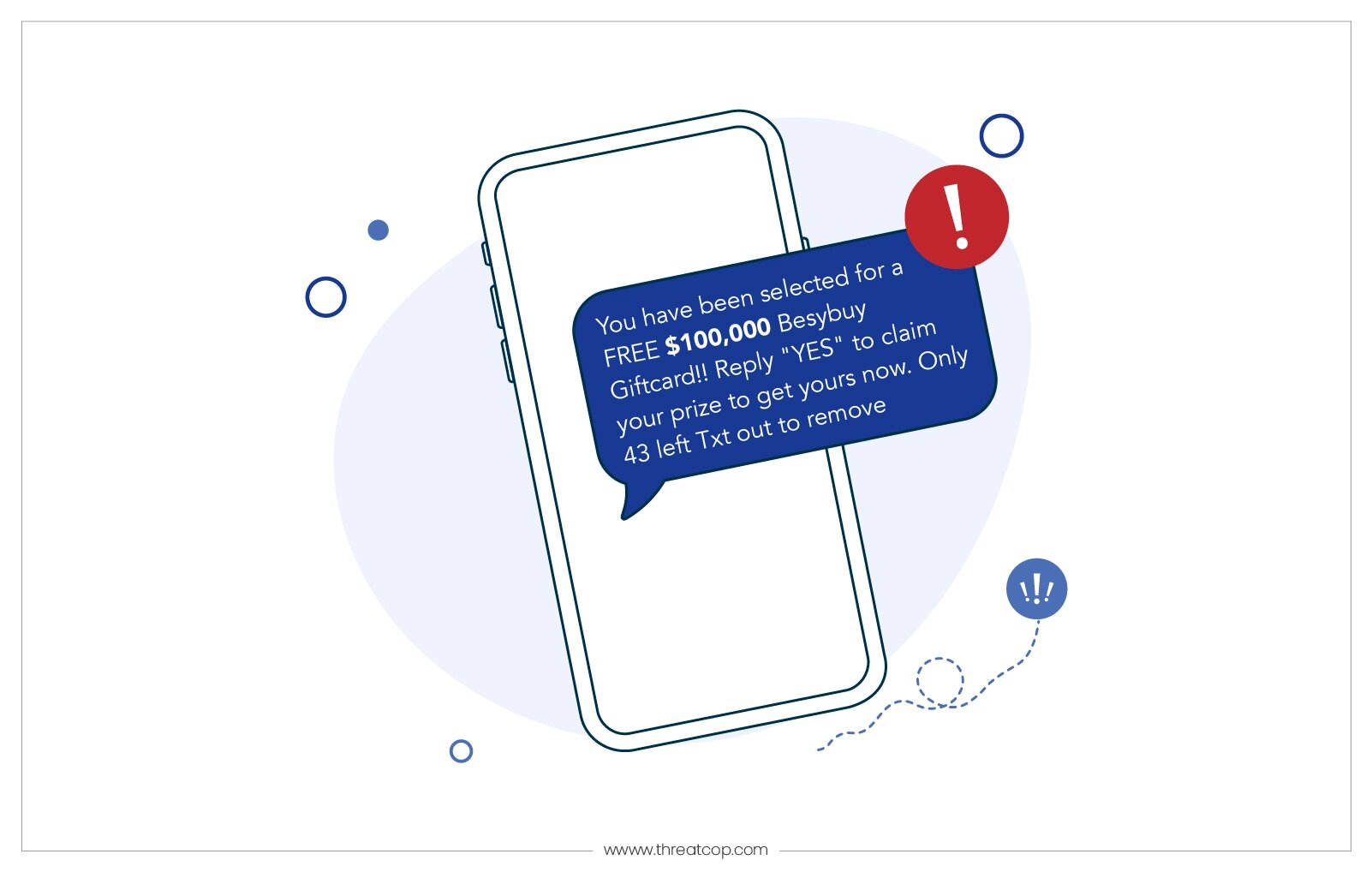Attackers have found new techniques and methodologies which makes it difficult to differentiate between what is real and what is fake. Organizations need to face heavy monetary losses and reputational damage due to the continuous increase in cyberattacks every year.
Table of Contents
ToggleAs per the statistics by IBM, 75% of organizations globally reported experiencing smishing attacks which raises a concern about the widespread nature of this cyberthreat. Smishing (SMS Phishing) are being used by attackers to take advantage of lack of security awareness among the employees and convince them to reveal confidential organization details.
To safeguard organizations against these modern smishing attacks it demands proper cybersecurity awareness training for employees to enhance their knowledge about cyberattacks and the need to apply mitigation strategies to deal with real-world smishing attacks.
In this blog, we will be understanding about the definition of smishing attacks, their working, and various preventive measures that need to be applied against smishing attacks.
What is a Smishing Attack?
Smishing is made with the combination of two words “SMS” and “Phishing.” It is a type of phishing attack in which attackers use SMS messages to trick individuals or employees into revealing private details.
Scamsters use impersonation techniques to appear as legitimate sources. The next stage involves sending text messages to the victim and convincing them to click on suspicious links. They urge them to provide confidential details.
Clicking on these suspicious links directs the victim to fraudulent websites which are designed to steal sensitive information and infect your IT peripherals with malware and trojans.
Book a Free Demo Call with Our People Security Expert
Enter your details
How Does Smishing Work?
Hackers use various techniques to appear as legitimate sources. To reduce the chances of becoming victims of a smishing attack it’s important to understand the working and techniques used by hackers. Following are the tricks used for successful smishing attempts:-
- Phishing Variant: Smishing is a variant of phishing attack but uses SMS instead of emails.
- Impersonation Techniques: Hackers impersonate trusted sources such as banks, government officials, and tech support.
- Fraudulent Links: Attackers trick users to click on suspicious and untrusted links which redirect users to malicious websites and infect devices with malware.
- Device Vulnerabilities: Link verification process in smartphones is difficult and could lead to an increased risk of becoming a victim of cyber fraud.
- Click Rates: Messages have higher click-through rates when compared with emails. By using these benefits of messages, it becomes more effective for hackers to conduct smishing attacks.
Types of Smishing Attacks Used by Attackers

- Bank/Credit Card Messages: Hackers target organizations by impersonating as financial institutions and request recipients to click on unknown links to resolve urgent issues.
- Delivery Notifications: Attackers send fraudulent messages about delivery packages and trick users to click on suspicious links.
- Fake Security Alerts: Some malicious or spam websites show fake prompts of security warnings. Clicking on these suspicious links can lead to data breaches.
- Password Reset: Fraudulent phishing websites show fake alerts and request users to reset passwords. These websites intend to capture sensitive user credentials.
- Business Communication: Impersonation techniques can be used by attackers to act as senior executives and colleagues. By using these tricks, employees can be tricked into transferring monetary funds or revealing confidential company details.
- Fake Prizes / Raffle win: Clicking on the suspicious messages that “you have won a prize” can redirect to phishing websites and steal personal details.
- Social Media Alerts: Scamsters can trick users on social media platforms by impersonating someone known or familiar.
Real-Life Example of Smishing Attacks
Spanish Tax Agency Smishing Attempt (January 2025)
- Incident: Attackers use SMS messages and impersonate Spain’s Tax Agency to demand personal details.
- Impact: The risk of user data compromises and chance of data leaks increased.
- Key Takeaways: Always verify the website and avoid clicking on suspicious links in messages
Source: HUFFPOST SPAIN
Revolut Smishing Attack (January 2025)
- Incident: Hackers targeted Revolut users by sending fake SMS, claiming identity verification issues. Clicking on this fraud messages directed the victims to phishing sites which stole personal and financial details of the users.
- Impact: Due to the incident, victims faced unauthorized transactions, financial loss, and identity theft.
- Key Takeaways: This incident highlighted the need to verify suspicious messages and avoid clicking on malicious links.
Source: AS.com
Smishing vs Phishing vs Vishing
People are often confused by various terms like smishing, phishing and vishing. They assume that all attacks are the same. To reduce this confusion its important to understand the differences so that employees are aware about various modern techniques used by attackers.
Following is the comparison table which is explaining differences about smishing, phishing and vishing attacks:-
|
Parameter |
Smishing |
Phishing |
Vishing |
|
Definition |
Fake SMS/text messages are intended to steal personal information or spread malware. |
Fraudulent emails or websites trick users into revealing confidential details. |
Fake phone calls are used for extracting sensitive information or scam victims. |
|
Communication |
SMS / Text messages |
Emails or fake websites |
Phone calls or voice messages |
|
Main Target |
Smartphone users |
Email account users |
Individuals via phone |
|
Example of the Attack |
“Your account is locked. Click this link to unlock.” |
“Verify your account to avoid deactivation. Click here.” |
“Your bank account has an issue. Please share your OTP now.” |
|
Delivery Methodology |
Text links, attachments. |
Links, attachments, and fake websites. |
Social engineering tactics over the call |
Preventive Strategies to Implement for Minimizing Smishing Attacks
- Avoidance: Avoid clicking on any links in messages that come from unknown or suspicious sources.
- Caution: Never respond to text messages that ask for your personal details such as login credentials, bank details, or social media handles.
- Verification: Always verify the legitimacy of the source before responding to any text message that looks like an alert or shows any urgency.
- Sender Identification: Look out for messages that are not sent via phone number. Scammers often mask their identity so that their location or identity cannot be tracked.
- Confidentiality: Never give away your bank details or financial information to any text message asking for your credentials or verification.
- Awareness: Cybersecurity researchers highly recommend organizations as well as individuals to use modern security awareness tools as a preventive measure.
- Authentication: Change your account PIN and passwords to avoid unauthorized logins. Also, add MFA to add an extra layer of security.
- Permission Management: While checking out various websites or applications, beware of unusual login sites and avoid giving unnecessary permissions.
- Training: Organizations need to train employees on modern simulations of various cyberattacks can help to enhance their threat identification and responding capabilities.
Conclusion
To tackle modern smishing attacks, organizations need to provide awareness training to the employees. Also, training on simulations, implementing security policies, and using threat detection solutions can help to reduce data breaches, financial loss, and reputational damage.
By using security awareness solutions and training on simulations of various cyberattacks can help organizations to reduce smishing attempts. To meet these modern needs, Threatcop has an AI-powered solution TSAT which provides simulations of multiple attack vectors and offers AI template generation to meet various training and learning requirements.
With the help of TSAT multi-language support and interactive way of learning, it makes it easy for employees to improve their knowledge of different security concepts and be ready against smishing attacks.
FAQs
It is a type of phishing attack carried out through mobile messages.
Following is an example of a smishing attack “Your account has been temporarily locked due to suspicious activity. Click the link below to verify your details and regain access: [FakeLink.com].”
It is a type of phishing attack.
There are 7 attack vectors present in TSAT:- Smishing, Vishing, Phishing, Ransomware, QR Code, WhatsApp Phishing and Attachment-based attack vectors are present.
Vishing: Fake phone calls are used to extract confidential details or scam victims.
Smishing: Fake SMS/text messages intended to steal personal details or spread malware.

Technical Content Writer at Threatcop
Milind Udbhav is a cybersecurity researcher and technology enthusiast. As a Technical Content Writer at Threatcop, he uses his research experience to create informative content which helps audience to understand core concepts easily.
Technical Content Writer at Threatcop Milind Udbhav is a cybersecurity researcher and technology enthusiast. As a Technical Content Writer at Threatcop, he uses his research experience to create informative content which helps audience to understand core concepts easily.
